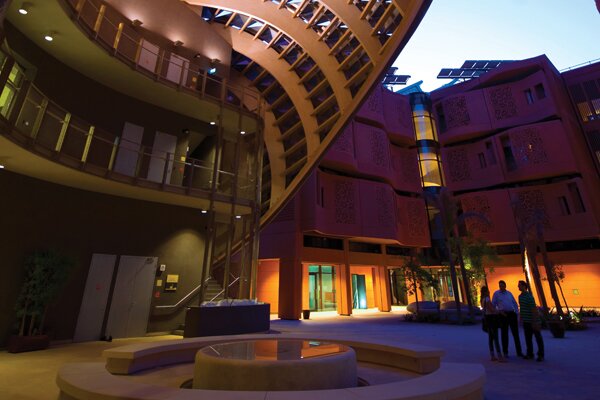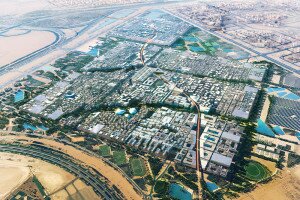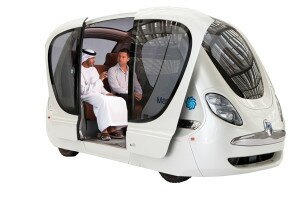With the environment becoming more and more important, Abu Dhabi Week checked out the progress at Masdar, the most sustainable city in the Middle East
One of the world’s most sustainable cities is right on our doorstep here in Abu Dhabi.
Abu Dhabi Week took a tour of Masdar City to explore this $15 billion eco-project, the trailblazer for sustainability in the Middle East.
We went along to see the city’s design manager, Chris Wan, meeting him in the foyer, which feels space age. Electronic transportation cars wait behind glass, like a scene out of a futuristic movie, we relaxed while the eco-friendly autopilot car drove us around.
The whole city is designed to encourage people to be environmentally friendly; the stairs are featured prominently while lifts are concealed to save electricity. Wan explained: “We make the stairs the main feature, making them artistic and interesting so people are too busy admiring the design to look for the elevators.”
Every fact we learnt was astounding; the city is solely solar-powered, made from recycled materials, it generates nearly one gigawatt of renewable energy, the architectural design of the buildings makes the walkways stay cooler, Masdar buildings use 70 percent
less electricity and potable water than normal buildings of similar size, and none of the windows receive direct sunlight to reduce energy consumption.
The company was established in 2006 and the city will be fully complete by 2025, complete with housing for 40,000 residents and 800 students at Masdar Institute. Phase two of Masdar’s plan will be unveiled in October, adding another 200-plus spaces for students at Masdar Institute.
Years ago, Masdar had a competition to find the ‘greenest’ concrete. Masdar used the recipe in their own concrete plant, giving it 30 percent less carbon emissions than conventional concrete.
We strolled through the sustainable courtyards, complete with water-features. Not normally the most economical landscaping choice, Masdar’s water-features are positioned in shade to minimise evaporation and use recycled water.
We felt cooler than normal, being outside; this is because Masdar is structured on an axis to maximise breezes and shade. This is all part of the concept – reducing energy outputs by logical organic methods. Wan says this is his favourite part of the three-tiered sustainability approach – passive design. The natural breezes that occur in Abu Dhabi predominantly come from the northwest; hence the buildings have open corridors parallel with the northwest. Cool air made walking in the 35 degree heat bearable … even comfortable.
Noticeable in Masdar is the lack of roads. It’s specifically designed to encourage the most environmentally friendly transport – walking. The buildings are positioned close together for a number of reasons, reduction in transport output being at the top of the list. It also gives off shade and creates air-flow making it an enjoyable place to walk.
We walked up to the wind tower, a cooling system in itself. The tower directs the wind downwards while cooling it. Cold air sinks, so the wind tower ends up funneling cool air into the courtyards. The wind tower also has LED lighting that changes colour according to energy use in the city to signal to residents, students and visitors what kind of energy consumption levels are at – blue for good and red for bad. Staff say they haven’t seen it lit red yet.
We walked to the Siemens Headquarters building. In the final stages of construction, the building, which just won a MEED award for sustainability, has four differently designed sides – each side has an environmental feature specific to its direction; the western side has solar-shading devices for protection from the afternoon sun.
In the distance, we could see the sprawling solar-field; which provides ten megawatts of power indirectly to Abu Dhabi city. Next to the field, was what looked like a dump, stacks of debris – scraps. “We recycle construction materials.” Wan tells us. “This would normally be landfill, but Masdar reuses it for our construction.” Masdar has a 90 percent recycling rate.
This isn’t surprising when walking amongst the buildings; every bin is a three-piece with a section for general waste, plastic and paper; recycling is automatic.
The Masdar vision is simple, what seems to be special methods and techniques in Masdar City, they hope will become commonplace methods and techniques – making an attractive landscape with logical and sustainable methods. Wan said it’s about sustainability and super-efficiency but also, people need to enjoy themselves. He said with a grin: “There is no point saving the planet if we are all going to
be miserable.”
The biggest challenges? Wan says two things; the supply and demand – being a part of Abu Dhabi means Masdar is susceptible to the same trends as the rest of the city. The residential district is not a priority at the moment because Abu Dhabi’s property market is over-supplied. “The most unsustainable building is an empty building.” He said. The other challenge is communicating knowledge. How to broadcast what has been learnt and how everyone can take an environmental approach.
Phase 1B will be unveiled in October, so stay tuned to Abu Dhabi Week for all the latest news!
For further information, visit www.masdar.ae
Personal Rapid Transit vehicles
The personal rapid transit (PRT) system is electronically operated, with a series of vehicles.
They are completely safe and are a foundation in Masdar’s approach to sustainable transport. These get up to 40km per hour and combine the advantages of public transport with the comfort of personal transport while having zero carbon emissions.
The PRT vehicles have a battery that is recharged while waiting in its station.
Navigation is done by a computer, which calculates the quickest route. The PRT vehicles then navigate using a series of magnets embedded in the ground.
The original idea was to use these as the primary source of transport around Masdar however, given the speed in which the electric vehicle industry is developing, it has become a more dynamic and flexible approach, says Wan. They expect a combination of electric vehicles to be used in future.
Our favourite feature – no need to find a car-park!
























